Research philosophy Assignment 2022
VerifiedAdded on 2022/10/11
|11
|2469
|25
Assignment
AI Summary
Contribute Materials
Your contribution can guide someone’s learning journey. Share your
documents today.

1. Research philosophy
From the definition of Galliers (1991) research philosophy is a belief regarding the procedure
that should be applied in collection and analysis of data regarding a certain phenomenon.
Choosing the best philosophy is a vital part of a study. From the study by Guba & Lincoln
(1982), philosophical paradigm within a study is significant as it is the “basic belief system
or world view that guides the investigation” (p. 105). Philosophy is defined in research as
the development and the nature if knowledge that is developed.
As illustrated by Hussey and Hussey (1997), there are two key research philosophies that
have been highlighted in science; they are positivist and interpretivist / anti-positivist. This is
explained by the research onion below.
Positivism involves working with a social reality that can be observed and using the results to
make generalisations in physical/natural sciences. Positivists assume that reality is stable and
is possible to be observed or even analysed from an objective viewpoint (Levin, 1988). They
contend that it’s necessary to isolate the phenomena and hence make the observations
repeatable. This approach is often associated with reality manipulation with only a single
From the definition of Galliers (1991) research philosophy is a belief regarding the procedure
that should be applied in collection and analysis of data regarding a certain phenomenon.
Choosing the best philosophy is a vital part of a study. From the study by Guba & Lincoln
(1982), philosophical paradigm within a study is significant as it is the “basic belief system
or world view that guides the investigation” (p. 105). Philosophy is defined in research as
the development and the nature if knowledge that is developed.
As illustrated by Hussey and Hussey (1997), there are two key research philosophies that
have been highlighted in science; they are positivist and interpretivist / anti-positivist. This is
explained by the research onion below.
Positivism involves working with a social reality that can be observed and using the results to
make generalisations in physical/natural sciences. Positivists assume that reality is stable and
is possible to be observed or even analysed from an objective viewpoint (Levin, 1988). They
contend that it’s necessary to isolate the phenomena and hence make the observations
repeatable. This approach is often associated with reality manipulation with only a single
Secure Best Marks with AI Grader
Need help grading? Try our AI Grader for instant feedback on your assignments.
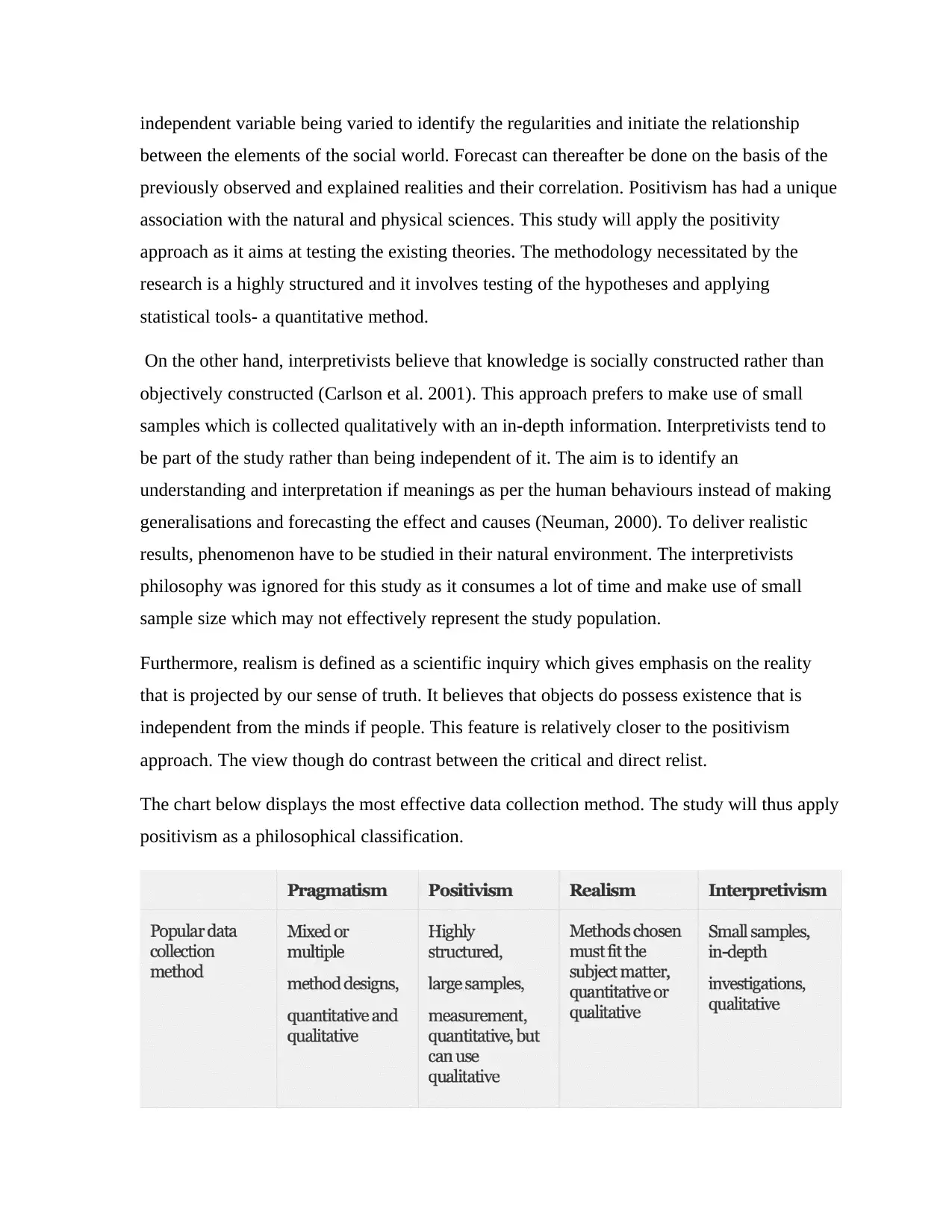
independent variable being varied to identify the regularities and initiate the relationship
between the elements of the social world. Forecast can thereafter be done on the basis of the
previously observed and explained realities and their correlation. Positivism has had a unique
association with the natural and physical sciences. This study will apply the positivity
approach as it aims at testing the existing theories. The methodology necessitated by the
research is a highly structured and it involves testing of the hypotheses and applying
statistical tools- a quantitative method.
On the other hand, interpretivists believe that knowledge is socially constructed rather than
objectively constructed (Carlson et al. 2001). This approach prefers to make use of small
samples which is collected qualitatively with an in-depth information. Interpretivists tend to
be part of the study rather than being independent of it. The aim is to identify an
understanding and interpretation if meanings as per the human behaviours instead of making
generalisations and forecasting the effect and causes (Neuman, 2000). To deliver realistic
results, phenomenon have to be studied in their natural environment. The interpretivists
philosophy was ignored for this study as it consumes a lot of time and make use of small
sample size which may not effectively represent the study population.
Furthermore, realism is defined as a scientific inquiry which gives emphasis on the reality
that is projected by our sense of truth. It believes that objects do possess existence that is
independent from the minds if people. This feature is relatively closer to the positivism
approach. The view though do contrast between the critical and direct relist.
The chart below displays the most effective data collection method. The study will thus apply
positivism as a philosophical classification.
between the elements of the social world. Forecast can thereafter be done on the basis of the
previously observed and explained realities and their correlation. Positivism has had a unique
association with the natural and physical sciences. This study will apply the positivity
approach as it aims at testing the existing theories. The methodology necessitated by the
research is a highly structured and it involves testing of the hypotheses and applying
statistical tools- a quantitative method.
On the other hand, interpretivists believe that knowledge is socially constructed rather than
objectively constructed (Carlson et al. 2001). This approach prefers to make use of small
samples which is collected qualitatively with an in-depth information. Interpretivists tend to
be part of the study rather than being independent of it. The aim is to identify an
understanding and interpretation if meanings as per the human behaviours instead of making
generalisations and forecasting the effect and causes (Neuman, 2000). To deliver realistic
results, phenomenon have to be studied in their natural environment. The interpretivists
philosophy was ignored for this study as it consumes a lot of time and make use of small
sample size which may not effectively represent the study population.
Furthermore, realism is defined as a scientific inquiry which gives emphasis on the reality
that is projected by our sense of truth. It believes that objects do possess existence that is
independent from the minds if people. This feature is relatively closer to the positivism
approach. The view though do contrast between the critical and direct relist.
The chart below displays the most effective data collection method. The study will thus apply
positivism as a philosophical classification.
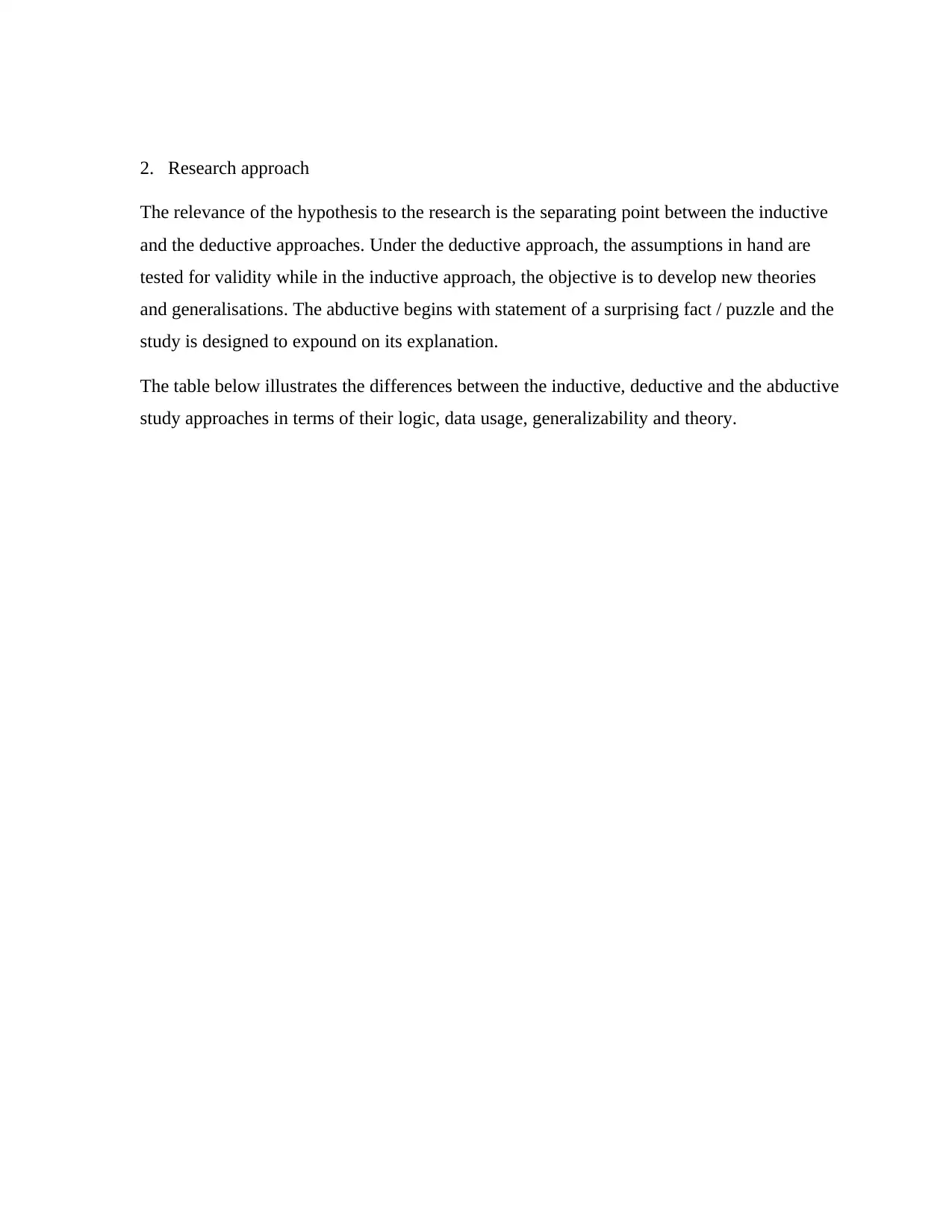
2. Research approach
The relevance of the hypothesis to the research is the separating point between the inductive
and the deductive approaches. Under the deductive approach, the assumptions in hand are
tested for validity while in the inductive approach, the objective is to develop new theories
and generalisations. The abductive begins with statement of a surprising fact / puzzle and the
study is designed to expound on its explanation.
The table below illustrates the differences between the inductive, deductive and the abductive
study approaches in terms of their logic, data usage, generalizability and theory.
The relevance of the hypothesis to the research is the separating point between the inductive
and the deductive approaches. Under the deductive approach, the assumptions in hand are
tested for validity while in the inductive approach, the objective is to develop new theories
and generalisations. The abductive begins with statement of a surprising fact / puzzle and the
study is designed to expound on its explanation.
The table below illustrates the differences between the inductive, deductive and the abductive
study approaches in terms of their logic, data usage, generalizability and theory.
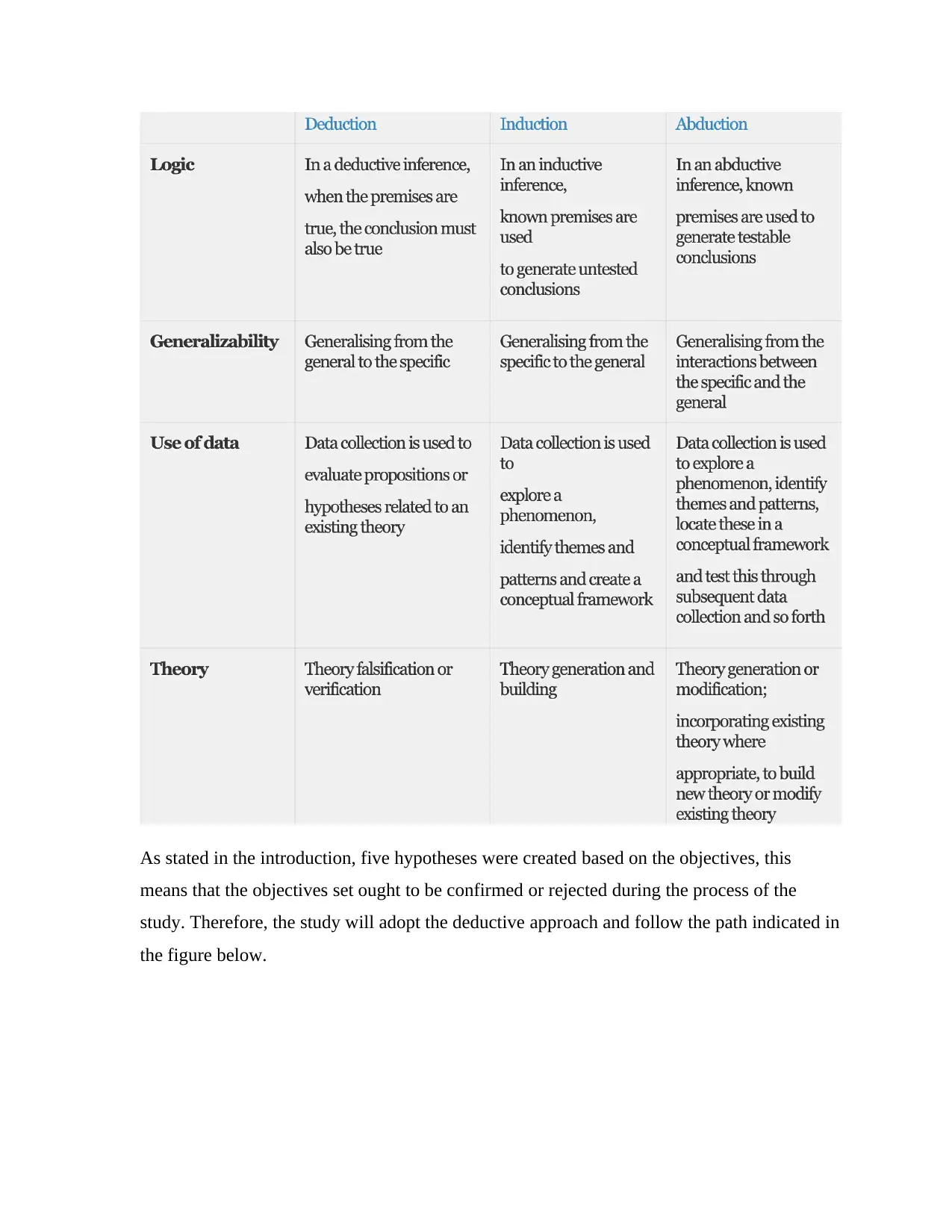
As stated in the introduction, five hypotheses were created based on the objectives, this
means that the objectives set ought to be confirmed or rejected during the process of the
study. Therefore, the study will adopt the deductive approach and follow the path indicated in
the figure below.
means that the objectives set ought to be confirmed or rejected during the process of the
study. Therefore, the study will adopt the deductive approach and follow the path indicated in
the figure below.
Secure Best Marks with AI Grader
Need help grading? Try our AI Grader for instant feedback on your assignments.
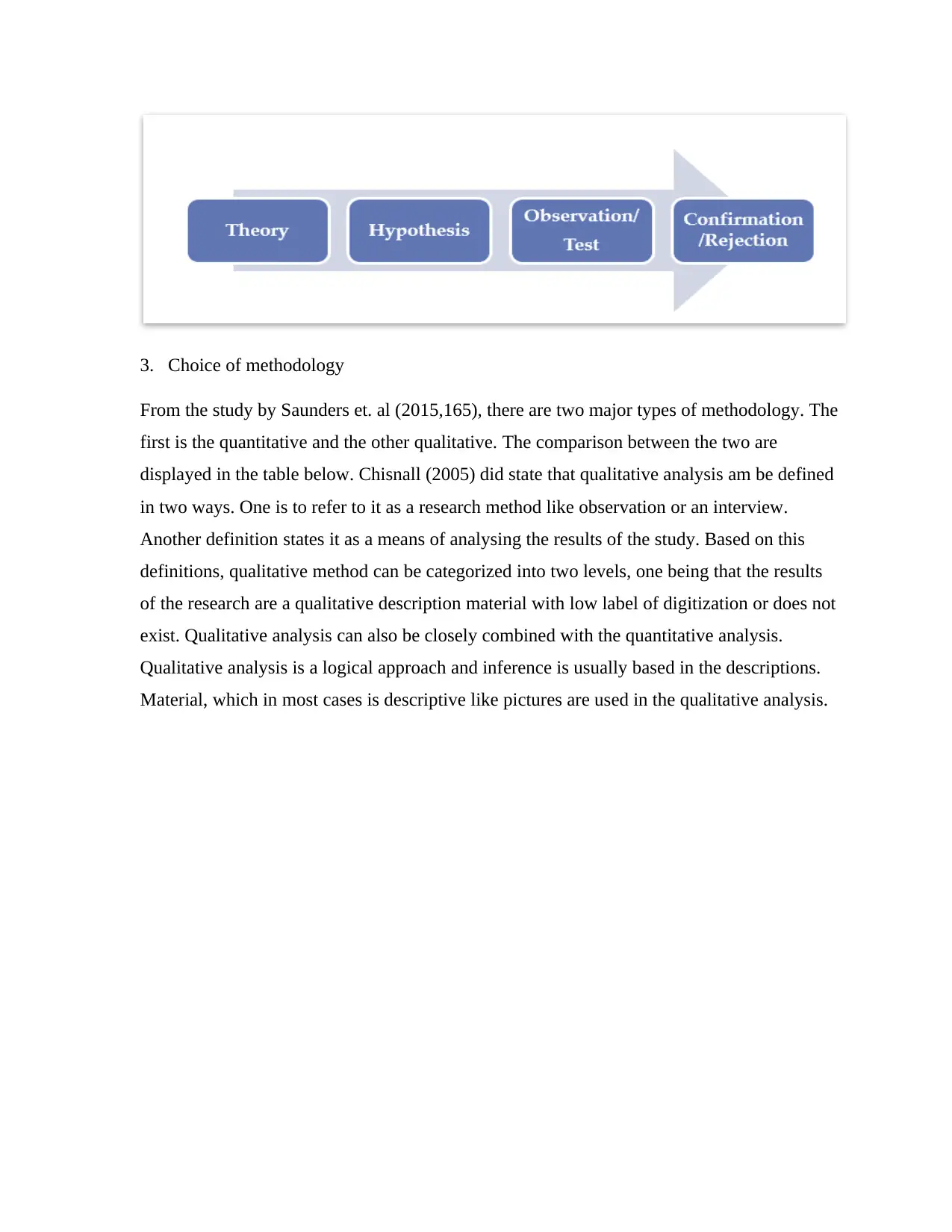
3. Choice of methodology
From the study by Saunders et. al (2015,165), there are two major types of methodology. The
first is the quantitative and the other qualitative. The comparison between the two are
displayed in the table below. Chisnall (2005) did state that qualitative analysis am be defined
in two ways. One is to refer to it as a research method like observation or an interview.
Another definition states it as a means of analysing the results of the study. Based on this
definitions, qualitative method can be categorized into two levels, one being that the results
of the research are a qualitative description material with low label of digitization or does not
exist. Qualitative analysis can also be closely combined with the quantitative analysis.
Qualitative analysis is a logical approach and inference is usually based in the descriptions.
Material, which in most cases is descriptive like pictures are used in the qualitative analysis.
From the study by Saunders et. al (2015,165), there are two major types of methodology. The
first is the quantitative and the other qualitative. The comparison between the two are
displayed in the table below. Chisnall (2005) did state that qualitative analysis am be defined
in two ways. One is to refer to it as a research method like observation or an interview.
Another definition states it as a means of analysing the results of the study. Based on this
definitions, qualitative method can be categorized into two levels, one being that the results
of the research are a qualitative description material with low label of digitization or does not
exist. Qualitative analysis can also be closely combined with the quantitative analysis.
Qualitative analysis is a logical approach and inference is usually based in the descriptions.
Material, which in most cases is descriptive like pictures are used in the qualitative analysis.

According to Bryman and Bell (2003), research refers to a creative and systematic work
which undertaken to increase the magnitude of information that can clarify a given
phenomenon. Taking into account the aim and objectives of this proposed research, a mono
method quantitative approach to obtain the primary data is considered most appropriate. To
give farther clarification, the study is aimed at obtaining quantifiable insights into behaviour
and motivation using a structured research with a population sample rather than
understanding these manners in a less structured approach. This study is thus similar to most
of the quantitative studies.
From the statement by Payne and Payne (2004, p.180), the author did affirm that
“Quantitative methods (normally using deductive logic) seek regularities in human lives, by
separating the social world into empirical components called variables which can be
represented numerically as frequencies or rate, whose associations with each other can be
explored by statistical techniques and accessed through researcher-introduced stimuli and
systematic measurement.”
which undertaken to increase the magnitude of information that can clarify a given
phenomenon. Taking into account the aim and objectives of this proposed research, a mono
method quantitative approach to obtain the primary data is considered most appropriate. To
give farther clarification, the study is aimed at obtaining quantifiable insights into behaviour
and motivation using a structured research with a population sample rather than
understanding these manners in a less structured approach. This study is thus similar to most
of the quantitative studies.
From the statement by Payne and Payne (2004, p.180), the author did affirm that
“Quantitative methods (normally using deductive logic) seek regularities in human lives, by
separating the social world into empirical components called variables which can be
represented numerically as frequencies or rate, whose associations with each other can be
explored by statistical techniques and accessed through researcher-introduced stimuli and
systematic measurement.”
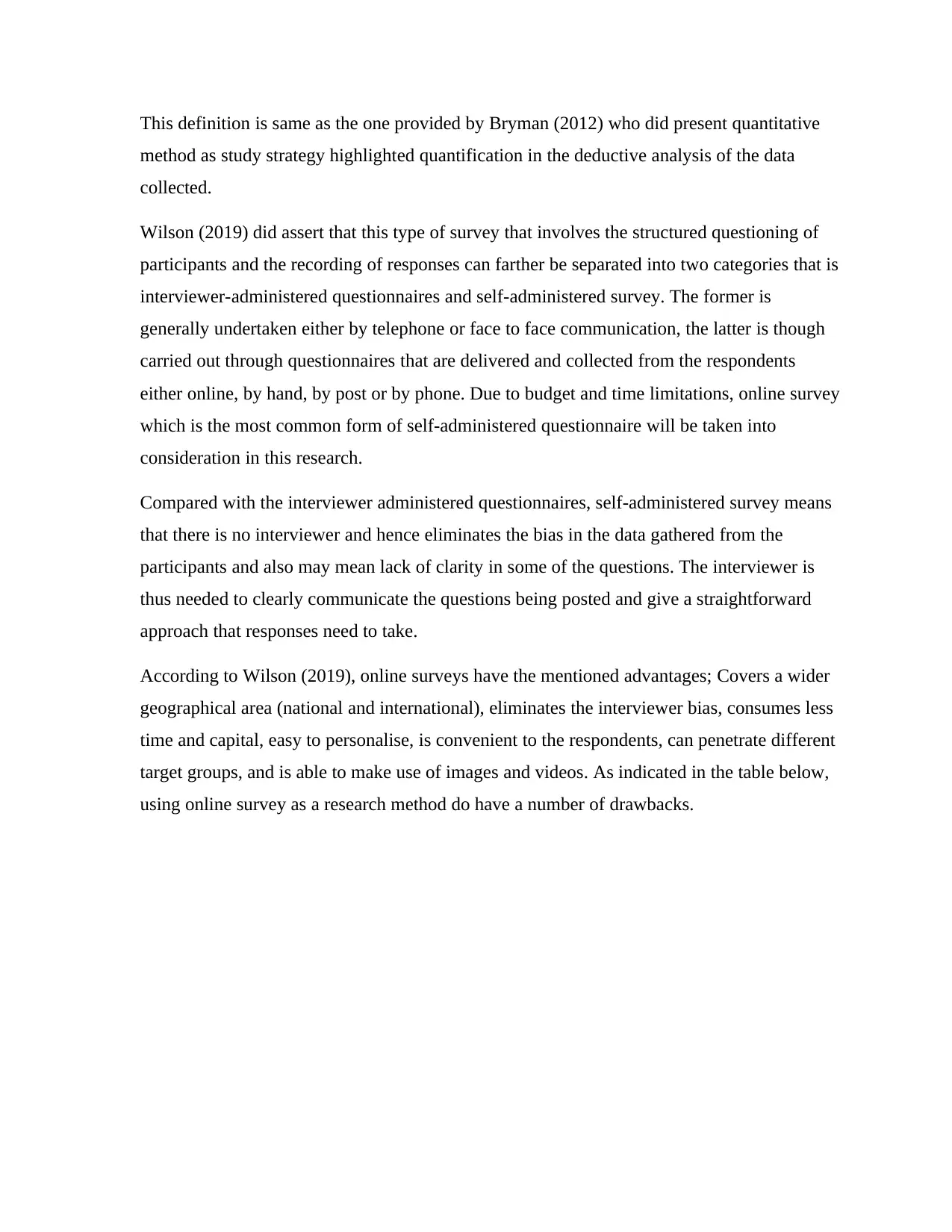
This definition is same as the one provided by Bryman (2012) who did present quantitative
method as study strategy highlighted quantification in the deductive analysis of the data
collected.
Wilson (2019) did assert that this type of survey that involves the structured questioning of
participants and the recording of responses can farther be separated into two categories that is
interviewer-administered questionnaires and self-administered survey. The former is
generally undertaken either by telephone or face to face communication, the latter is though
carried out through questionnaires that are delivered and collected from the respondents
either online, by hand, by post or by phone. Due to budget and time limitations, online survey
which is the most common form of self-administered questionnaire will be taken into
consideration in this research.
Compared with the interviewer administered questionnaires, self-administered survey means
that there is no interviewer and hence eliminates the bias in the data gathered from the
participants and also may mean lack of clarity in some of the questions. The interviewer is
thus needed to clearly communicate the questions being posted and give a straightforward
approach that responses need to take.
According to Wilson (2019), online surveys have the mentioned advantages; Covers a wider
geographical area (national and international), eliminates the interviewer bias, consumes less
time and capital, easy to personalise, is convenient to the respondents, can penetrate different
target groups, and is able to make use of images and videos. As indicated in the table below,
using online survey as a research method do have a number of drawbacks.
method as study strategy highlighted quantification in the deductive analysis of the data
collected.
Wilson (2019) did assert that this type of survey that involves the structured questioning of
participants and the recording of responses can farther be separated into two categories that is
interviewer-administered questionnaires and self-administered survey. The former is
generally undertaken either by telephone or face to face communication, the latter is though
carried out through questionnaires that are delivered and collected from the respondents
either online, by hand, by post or by phone. Due to budget and time limitations, online survey
which is the most common form of self-administered questionnaire will be taken into
consideration in this research.
Compared with the interviewer administered questionnaires, self-administered survey means
that there is no interviewer and hence eliminates the bias in the data gathered from the
participants and also may mean lack of clarity in some of the questions. The interviewer is
thus needed to clearly communicate the questions being posted and give a straightforward
approach that responses need to take.
According to Wilson (2019), online surveys have the mentioned advantages; Covers a wider
geographical area (national and international), eliminates the interviewer bias, consumes less
time and capital, easy to personalise, is convenient to the respondents, can penetrate different
target groups, and is able to make use of images and videos. As indicated in the table below,
using online survey as a research method do have a number of drawbacks.
Paraphrase This Document
Need a fresh take? Get an instant paraphrase of this document with our AI Paraphraser
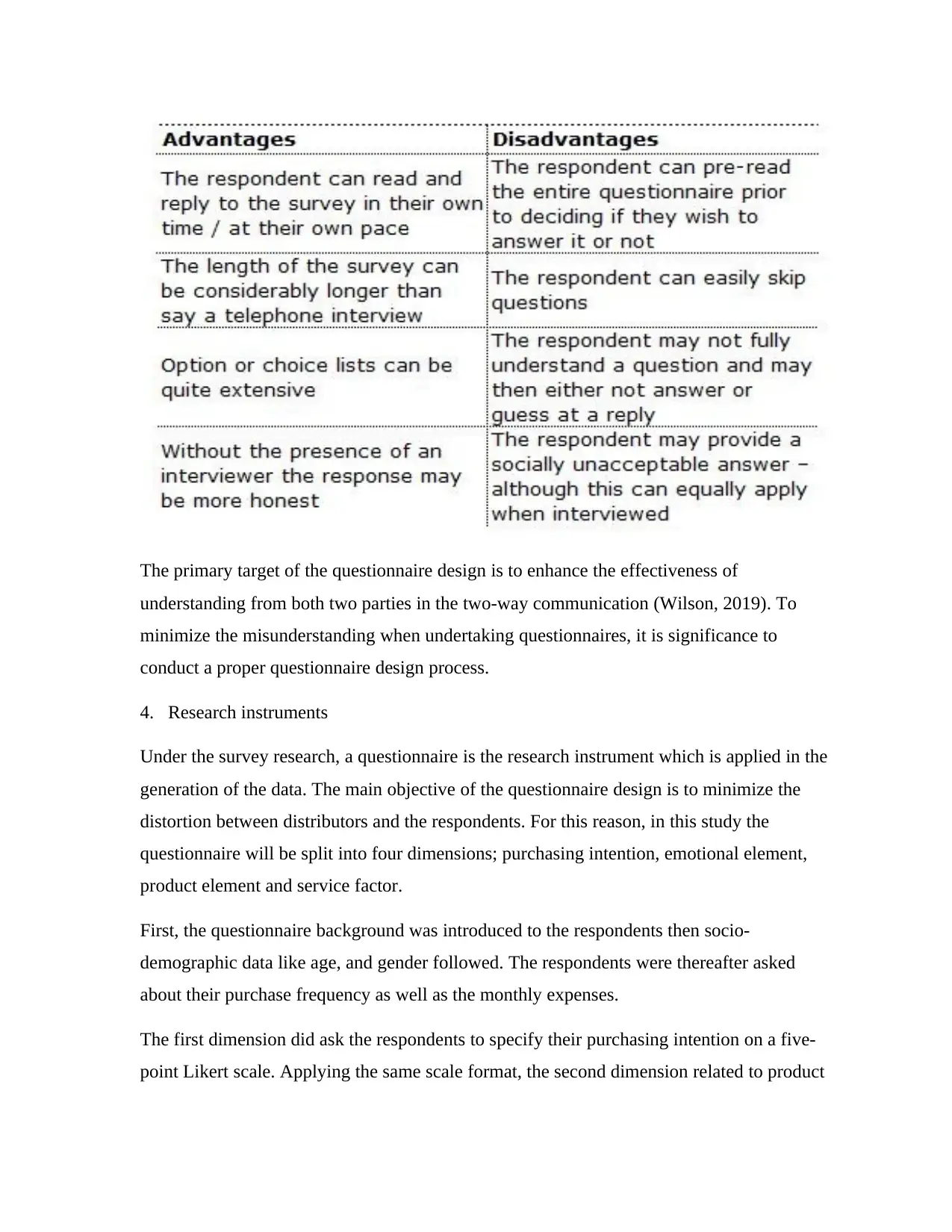
The primary target of the questionnaire design is to enhance the effectiveness of
understanding from both two parties in the two-way communication (Wilson, 2019). To
minimize the misunderstanding when undertaking questionnaires, it is significance to
conduct a proper questionnaire design process.
4. Research instruments
Under the survey research, a questionnaire is the research instrument which is applied in the
generation of the data. The main objective of the questionnaire design is to minimize the
distortion between distributors and the respondents. For this reason, in this study the
questionnaire will be split into four dimensions; purchasing intention, emotional element,
product element and service factor.
First, the questionnaire background was introduced to the respondents then socio-
demographic data like age, and gender followed. The respondents were thereafter asked
about their purchase frequency as well as the monthly expenses.
The first dimension did ask the respondents to specify their purchasing intention on a five-
point Likert scale. Applying the same scale format, the second dimension related to product
understanding from both two parties in the two-way communication (Wilson, 2019). To
minimize the misunderstanding when undertaking questionnaires, it is significance to
conduct a proper questionnaire design process.
4. Research instruments
Under the survey research, a questionnaire is the research instrument which is applied in the
generation of the data. The main objective of the questionnaire design is to minimize the
distortion between distributors and the respondents. For this reason, in this study the
questionnaire will be split into four dimensions; purchasing intention, emotional element,
product element and service factor.
First, the questionnaire background was introduced to the respondents then socio-
demographic data like age, and gender followed. The respondents were thereafter asked
about their purchase frequency as well as the monthly expenses.
The first dimension did ask the respondents to specify their purchasing intention on a five-
point Likert scale. Applying the same scale format, the second dimension related to product
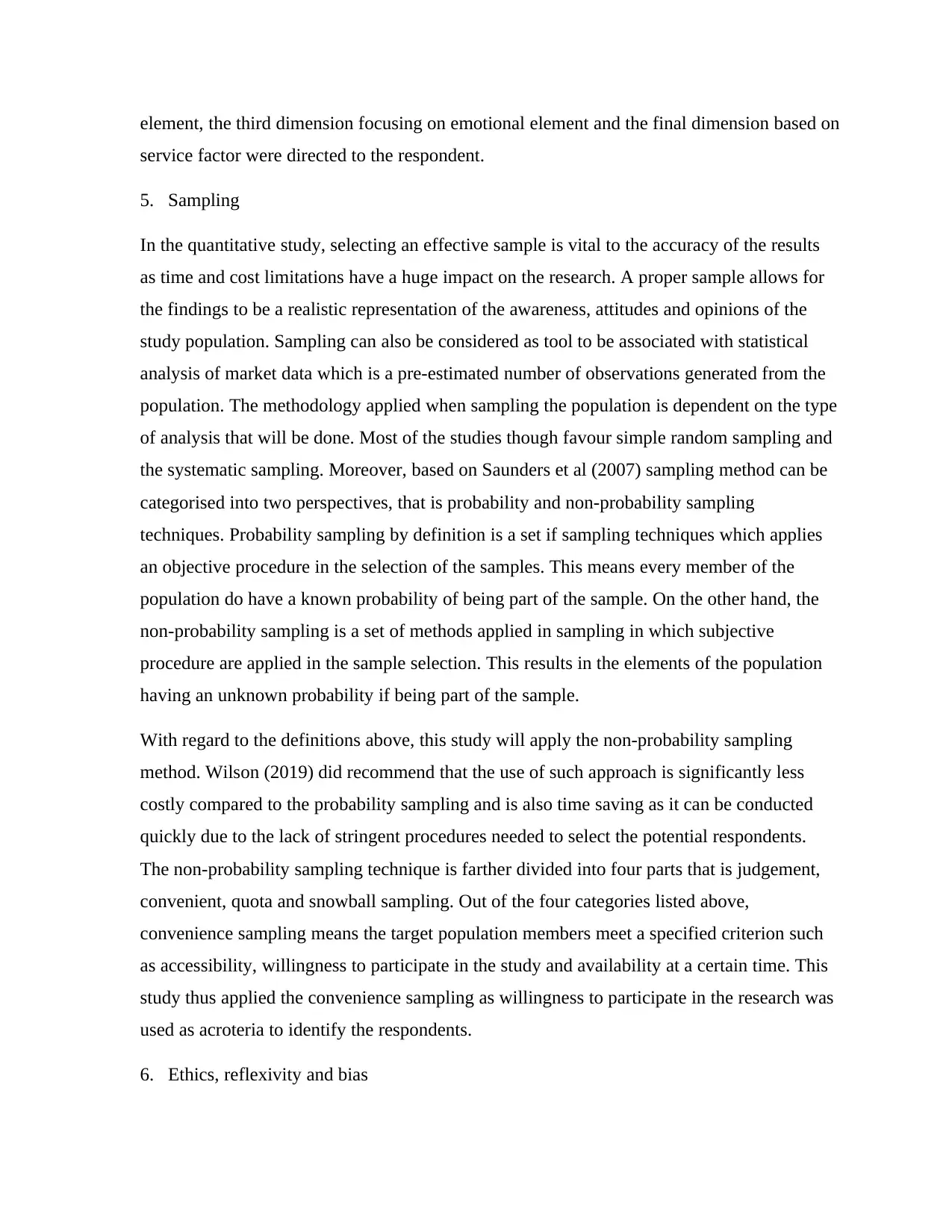
element, the third dimension focusing on emotional element and the final dimension based on
service factor were directed to the respondent.
5. Sampling
In the quantitative study, selecting an effective sample is vital to the accuracy of the results
as time and cost limitations have a huge impact on the research. A proper sample allows for
the findings to be a realistic representation of the awareness, attitudes and opinions of the
study population. Sampling can also be considered as tool to be associated with statistical
analysis of market data which is a pre-estimated number of observations generated from the
population. The methodology applied when sampling the population is dependent on the type
of analysis that will be done. Most of the studies though favour simple random sampling and
the systematic sampling. Moreover, based on Saunders et al (2007) sampling method can be
categorised into two perspectives, that is probability and non-probability sampling
techniques. Probability sampling by definition is a set if sampling techniques which applies
an objective procedure in the selection of the samples. This means every member of the
population do have a known probability of being part of the sample. On the other hand, the
non-probability sampling is a set of methods applied in sampling in which subjective
procedure are applied in the sample selection. This results in the elements of the population
having an unknown probability if being part of the sample.
With regard to the definitions above, this study will apply the non-probability sampling
method. Wilson (2019) did recommend that the use of such approach is significantly less
costly compared to the probability sampling and is also time saving as it can be conducted
quickly due to the lack of stringent procedures needed to select the potential respondents.
The non-probability sampling technique is farther divided into four parts that is judgement,
convenient, quota and snowball sampling. Out of the four categories listed above,
convenience sampling means the target population members meet a specified criterion such
as accessibility, willingness to participate in the study and availability at a certain time. This
study thus applied the convenience sampling as willingness to participate in the research was
used as acroteria to identify the respondents.
6. Ethics, reflexivity and bias
service factor were directed to the respondent.
5. Sampling
In the quantitative study, selecting an effective sample is vital to the accuracy of the results
as time and cost limitations have a huge impact on the research. A proper sample allows for
the findings to be a realistic representation of the awareness, attitudes and opinions of the
study population. Sampling can also be considered as tool to be associated with statistical
analysis of market data which is a pre-estimated number of observations generated from the
population. The methodology applied when sampling the population is dependent on the type
of analysis that will be done. Most of the studies though favour simple random sampling and
the systematic sampling. Moreover, based on Saunders et al (2007) sampling method can be
categorised into two perspectives, that is probability and non-probability sampling
techniques. Probability sampling by definition is a set if sampling techniques which applies
an objective procedure in the selection of the samples. This means every member of the
population do have a known probability of being part of the sample. On the other hand, the
non-probability sampling is a set of methods applied in sampling in which subjective
procedure are applied in the sample selection. This results in the elements of the population
having an unknown probability if being part of the sample.
With regard to the definitions above, this study will apply the non-probability sampling
method. Wilson (2019) did recommend that the use of such approach is significantly less
costly compared to the probability sampling and is also time saving as it can be conducted
quickly due to the lack of stringent procedures needed to select the potential respondents.
The non-probability sampling technique is farther divided into four parts that is judgement,
convenient, quota and snowball sampling. Out of the four categories listed above,
convenience sampling means the target population members meet a specified criterion such
as accessibility, willingness to participate in the study and availability at a certain time. This
study thus applied the convenience sampling as willingness to participate in the research was
used as acroteria to identify the respondents.
6. Ethics, reflexivity and bias
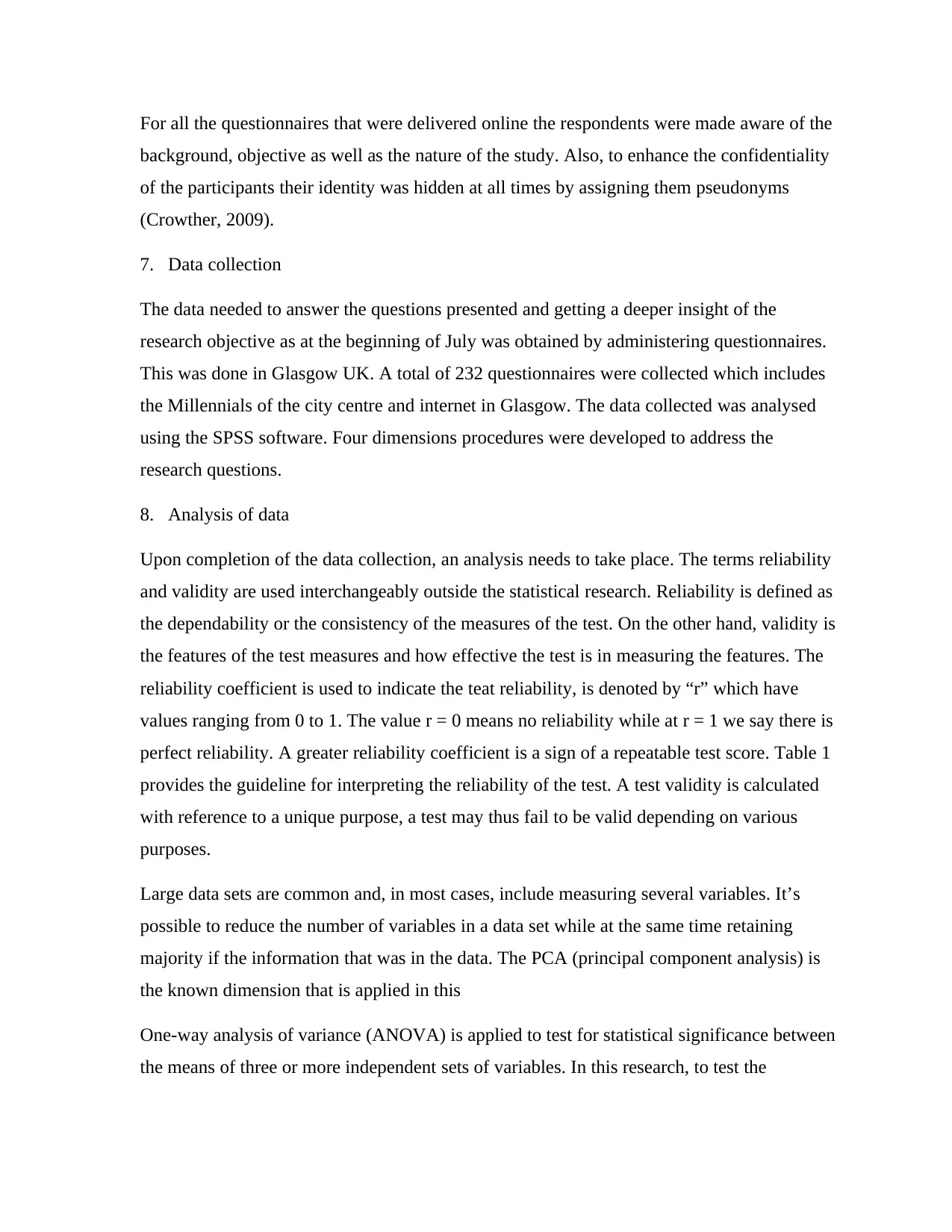
For all the questionnaires that were delivered online the respondents were made aware of the
background, objective as well as the nature of the study. Also, to enhance the confidentiality
of the participants their identity was hidden at all times by assigning them pseudonyms
(Crowther, 2009).
7. Data collection
The data needed to answer the questions presented and getting a deeper insight of the
research objective as at the beginning of July was obtained by administering questionnaires.
This was done in Glasgow UK. A total of 232 questionnaires were collected which includes
the Millennials of the city centre and internet in Glasgow. The data collected was analysed
using the SPSS software. Four dimensions procedures were developed to address the
research questions.
8. Analysis of data
Upon completion of the data collection, an analysis needs to take place. The terms reliability
and validity are used interchangeably outside the statistical research. Reliability is defined as
the dependability or the consistency of the measures of the test. On the other hand, validity is
the features of the test measures and how effective the test is in measuring the features. The
reliability coefficient is used to indicate the teat reliability, is denoted by “r” which have
values ranging from 0 to 1. The value r = 0 means no reliability while at r = 1 we say there is
perfect reliability. A greater reliability coefficient is a sign of a repeatable test score. Table 1
provides the guideline for interpreting the reliability of the test. A test validity is calculated
with reference to a unique purpose, a test may thus fail to be valid depending on various
purposes.
Large data sets are common and, in most cases, include measuring several variables. It’s
possible to reduce the number of variables in a data set while at the same time retaining
majority if the information that was in the data. The PCA (principal component analysis) is
the known dimension that is applied in this
One-way analysis of variance (ANOVA) is applied to test for statistical significance between
the means of three or more independent sets of variables. In this research, to test the
background, objective as well as the nature of the study. Also, to enhance the confidentiality
of the participants their identity was hidden at all times by assigning them pseudonyms
(Crowther, 2009).
7. Data collection
The data needed to answer the questions presented and getting a deeper insight of the
research objective as at the beginning of July was obtained by administering questionnaires.
This was done in Glasgow UK. A total of 232 questionnaires were collected which includes
the Millennials of the city centre and internet in Glasgow. The data collected was analysed
using the SPSS software. Four dimensions procedures were developed to address the
research questions.
8. Analysis of data
Upon completion of the data collection, an analysis needs to take place. The terms reliability
and validity are used interchangeably outside the statistical research. Reliability is defined as
the dependability or the consistency of the measures of the test. On the other hand, validity is
the features of the test measures and how effective the test is in measuring the features. The
reliability coefficient is used to indicate the teat reliability, is denoted by “r” which have
values ranging from 0 to 1. The value r = 0 means no reliability while at r = 1 we say there is
perfect reliability. A greater reliability coefficient is a sign of a repeatable test score. Table 1
provides the guideline for interpreting the reliability of the test. A test validity is calculated
with reference to a unique purpose, a test may thus fail to be valid depending on various
purposes.
Large data sets are common and, in most cases, include measuring several variables. It’s
possible to reduce the number of variables in a data set while at the same time retaining
majority if the information that was in the data. The PCA (principal component analysis) is
the known dimension that is applied in this
One-way analysis of variance (ANOVA) is applied to test for statistical significance between
the means of three or more independent sets of variables. In this research, to test the
Secure Best Marks with AI Grader
Need help grading? Try our AI Grader for instant feedback on your assignments.
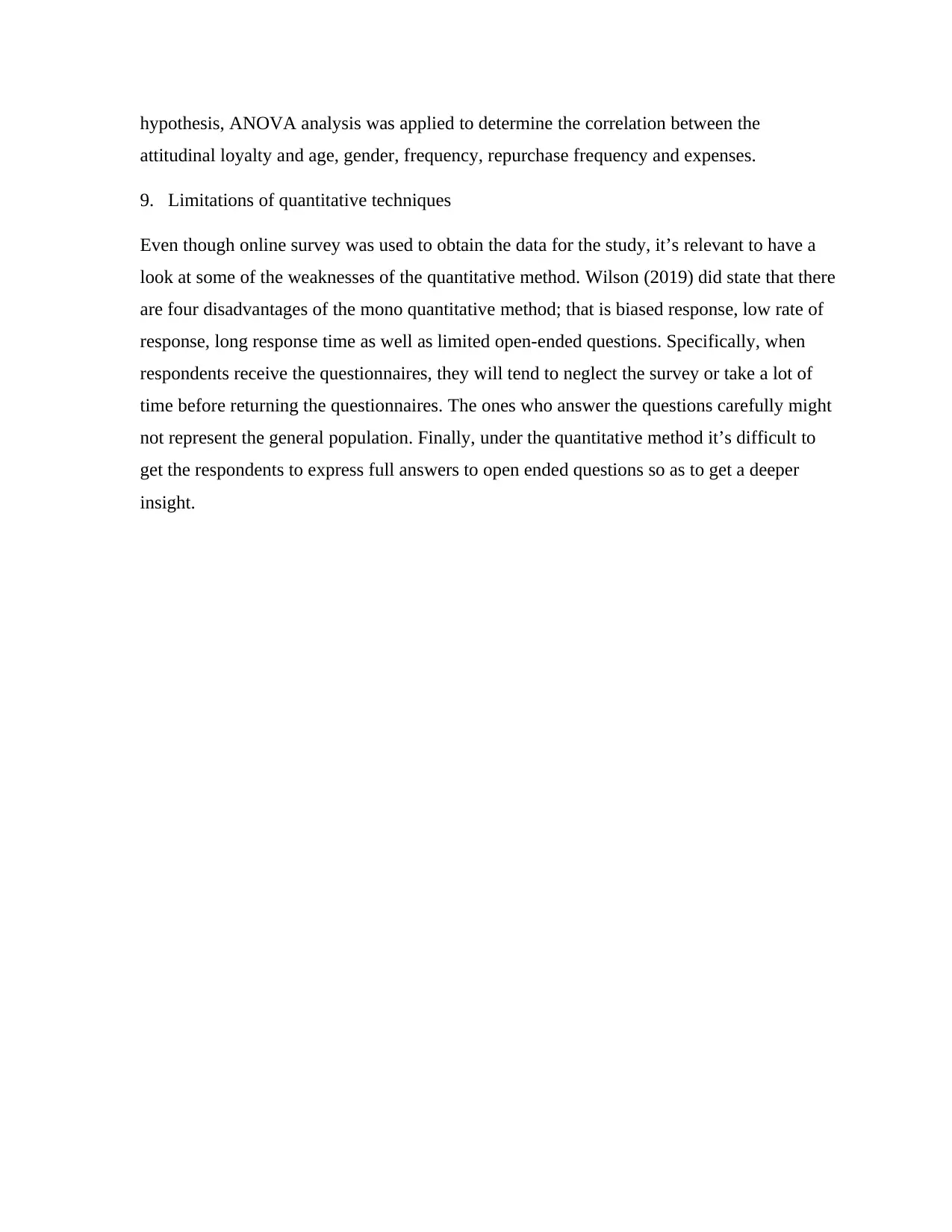
hypothesis, ANOVA analysis was applied to determine the correlation between the
attitudinal loyalty and age, gender, frequency, repurchase frequency and expenses.
9. Limitations of quantitative techniques
Even though online survey was used to obtain the data for the study, it’s relevant to have a
look at some of the weaknesses of the quantitative method. Wilson (2019) did state that there
are four disadvantages of the mono quantitative method; that is biased response, low rate of
response, long response time as well as limited open-ended questions. Specifically, when
respondents receive the questionnaires, they will tend to neglect the survey or take a lot of
time before returning the questionnaires. The ones who answer the questions carefully might
not represent the general population. Finally, under the quantitative method it’s difficult to
get the respondents to express full answers to open ended questions so as to get a deeper
insight.
attitudinal loyalty and age, gender, frequency, repurchase frequency and expenses.
9. Limitations of quantitative techniques
Even though online survey was used to obtain the data for the study, it’s relevant to have a
look at some of the weaknesses of the quantitative method. Wilson (2019) did state that there
are four disadvantages of the mono quantitative method; that is biased response, low rate of
response, long response time as well as limited open-ended questions. Specifically, when
respondents receive the questionnaires, they will tend to neglect the survey or take a lot of
time before returning the questionnaires. The ones who answer the questions carefully might
not represent the general population. Finally, under the quantitative method it’s difficult to
get the respondents to express full answers to open ended questions so as to get a deeper
insight.
1 out of 11
Related Documents
Your All-in-One AI-Powered Toolkit for Academic Success.
+13062052269
info@desklib.com
Available 24*7 on WhatsApp / Email
![[object Object]](/_next/static/media/star-bottom.7253800d.svg)
Unlock your academic potential
© 2024 | Zucol Services PVT LTD | All rights reserved.





